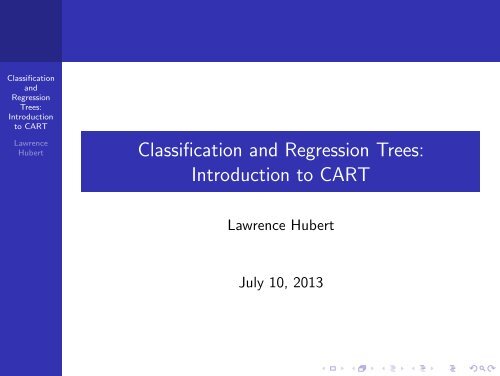Classification and Regression Trees: Introduction to CART
Classification and Regression Trees: Introduction to CART
Classification and Regression Trees: Introduction to CART
- No tags were found...
You also want an ePaper? Increase the reach of your titles
YUMPU automatically turns print PDFs into web optimized ePapers that Google loves.
<strong>Classification</strong><strong>and</strong><strong>Regression</strong><strong>Trees</strong>:<strong>Introduction</strong><strong>to</strong> <strong>CART</strong>LawrenceHubert<strong>Classification</strong> <strong>and</strong> <strong>Regression</strong> <strong>Trees</strong>:<strong>Introduction</strong> <strong>to</strong> <strong>CART</strong>Lawrence HubertJuly 10, 2013
The Basic Setup<strong>Classification</strong><strong>and</strong><strong>Regression</strong><strong>Trees</strong>:<strong>Introduction</strong><strong>to</strong> <strong>CART</strong>LawrenceHubertAn N × p matrix (of predic<strong>to</strong>rs), X; N is the number ofsubjects; p is the number of variables.An N × 1 vec<strong>to</strong>r (<strong>to</strong> be predicted; the “predictee”), Y.If Y contains nominal (categorical) data (with, say, Kcategories), we will construct a <strong>Classification</strong> Tree;a “classifier” uses the data in X <strong>to</strong> place a row in X in<strong>to</strong> aspecific category.
<strong>Classification</strong><strong>and</strong><strong>Regression</strong><strong>Trees</strong>:<strong>Introduction</strong><strong>to</strong> <strong>CART</strong>LawrenceHubertIf Y contains numerical values (that are not just used forlabeling), we will construct a <strong>Regression</strong> Tree.As an example. see the Medical Admissions (binary) tree in theSYSTAT manual on <strong>CART</strong> that you have.
Finding the Binary Splits<strong>Classification</strong><strong>and</strong><strong>Regression</strong><strong>Trees</strong>:<strong>Introduction</strong><strong>to</strong> <strong>CART</strong>LawrenceHubertFor each numerical (predic<strong>to</strong>r) variable, order its values fromsmallest <strong>to</strong> largest <strong>and</strong> look at the N − 1 possible splitsbetween adjacent values.For each categorical (predic<strong>to</strong>r) variable (with, say, Kcategories), evaluate all possible 2 K−1 − 1 splits of the categorycodes in<strong>to</strong> two groups.The best split is chosen <strong>to</strong> minimize the “impurity” of the tworesulting subsets that are formed.
Default Measures of Node Impurity<strong>Classification</strong><strong>and</strong><strong>Regression</strong><strong>Trees</strong>:<strong>Introduction</strong><strong>to</strong> <strong>CART</strong>LawrenceHubertFor numerical Y, use the within sum-of-squares for the twogroups formed by the split;For categorical Y, use the sum of the Gini diversity indices(“gdi”) over the two groups:for one group with proportions, p 1 , . . . , p K , over the K groups,gdi = 1 − ∑ Kk=1 p2 k .Thus, gdi = 0 when one proportion is 1; gdi is maximal whenthe proportions are all equal.
A Little His<strong>to</strong>ry <strong>and</strong> Terminology<strong>Classification</strong><strong>and</strong><strong>Regression</strong><strong>Trees</strong>:<strong>Introduction</strong><strong>to</strong> <strong>CART</strong>LawrenceHubertMorgan <strong>and</strong> Sonquist were the first (in the 1960s) <strong>to</strong> suggestthis type of “recursive partitioning”;they called it AID for “Au<strong>to</strong>matic Interaction Detection”.The major R routine for this is in the “rpart” set of programs.We could say it is “stagewise” <strong>and</strong> not “stepwise” – once asplit is made, we don’t revisit it.
<strong>Classification</strong><strong>and</strong><strong>Regression</strong><strong>Trees</strong>:<strong>Introduction</strong><strong>to</strong> <strong>CART</strong>LawrenceHubertAlso, the procedure is myopic, in that it only looks one stepahead;there is no guarantee of any overall optimality for the treesconstructed.We are looking for a good classifier that “st<strong>and</strong>s up” <strong>to</strong> testsamples <strong>and</strong>/or cross-validation.Remember, a “good fit” does not necessarily mean a “goodmodel”.The major reference <strong>and</strong> reason for current popularity:<strong>Classification</strong> <strong>and</strong> <strong>Regression</strong> <strong>Trees</strong> (1984) (Breiman; Friedman;Olshen; S<strong>to</strong>ne)
How <strong>to</strong> Use the Tree for Prediction<strong>Classification</strong><strong>and</strong><strong>Regression</strong><strong>Trees</strong>:<strong>Introduction</strong><strong>to</strong> <strong>CART</strong>LawrenceHubertFor a numerical Y, we can use the mean of the values from Ywithin the terminal subsets (nodes);For categorical Y, we can use the category with the greatestproportion (the majority or plurality) of observations in theterminal subsets (nodes).We could also impose differential costs of misclassification ordifferent prior probabilities of group membership – this is muchlike what we can do in using discriminant functions.
Confusion Errors<strong>Classification</strong><strong>and</strong><strong>Regression</strong><strong>Trees</strong>:<strong>Introduction</strong><strong>to</strong> <strong>CART</strong>LawrenceHubertSuppose two categories in Y (“success” <strong>and</strong> “failure”):Failure Prediction Success PredictedFailure a bSuccess c doverall error: (b + c)/(a + b + c + d)model errors: b/(a + b); c/(c + d)usage errors: c/(a + c); b/(b + d)
How <strong>to</strong> Evaluate Accuracy<strong>Classification</strong><strong>and</strong><strong>Regression</strong><strong>Trees</strong>:<strong>Introduction</strong><strong>to</strong> <strong>CART</strong>LawrenceHuberta) k-fold cross-validation (the default value of k is usually 10)the extreme of k = N is the “leave-one-out” optionb) bootstrap (about 1/3 of the observations are not resampled<strong>and</strong> can be used for cross-validation)these are called the “out-of-bag” (OOB) observationsIn either case, one “drops down” the tree the unsampled cases<strong>to</strong> see how well one does.
<strong>Classification</strong><strong>and</strong><strong>Regression</strong><strong>Trees</strong>:<strong>Introduction</strong><strong>to</strong> <strong>CART</strong>LawrenceHubertAll of this is very engineering oriented. The emphasis is mainlyon whether it “works” <strong>and</strong> not on the “why” or “how”.Thus, clever mechanisms <strong>to</strong> evaluate accuracy are crucial;cross-validation is central <strong>to</strong> the <strong>CART</strong> enterprise.For the behavioral sciences, we typically are also interested inthe predictive structure of the problem, i.e., the “how” <strong>and</strong>“why”.
Issues<strong>Classification</strong><strong>and</strong><strong>Regression</strong><strong>Trees</strong>:<strong>Introduction</strong><strong>to</strong> <strong>CART</strong>LawrenceHubertHow “deep” should the tree be grown (the “goldilocks”problem):<strong>to</strong>o deep, we “overfit” <strong>and</strong> get unstable prediction;not deep enough, we get inaccurate prediction.Strategies:a) Choose minimal leaf size by a cross-validation (samplereuse) mechanism;b) Draw a deep tree <strong>and</strong> “prune” back <strong>to</strong> get <strong>to</strong> the bestcross-validation level.A tree with one case per terminal node is called “saturated”.
Older Terminology<strong>Classification</strong><strong>and</strong><strong>Regression</strong><strong>Trees</strong>:<strong>Introduction</strong><strong>to</strong> <strong>CART</strong>LawrenceHubertA “training sample” (we are training the learner or classifier ifwe have a categorical Y).There is a “test sample” of new data not used in the trainingthat serves the purposes of cross-validation (<strong>and</strong> <strong>to</strong> assess“shrinkage”).If we “drop” the training sample down the tree, we get the“resubstitution estimate of error”.This is an overly optimistic estimate since the same data used<strong>to</strong> obtain the tree now serves as the means <strong>to</strong> evaluate it.
<strong>Classification</strong><strong>and</strong><strong>Regression</strong><strong>Trees</strong>:<strong>Introduction</strong><strong>to</strong> <strong>CART</strong>LawrenceHubertGoing <strong>to</strong> a saturated tree gives zero resubstitution error but itis terribly overfit <strong>and</strong> unstable;that is the reason for pruning back, or evaluating leaf sizethrough cross-validation.
Variable Combinations<strong>Classification</strong><strong>and</strong><strong>Regression</strong><strong>Trees</strong>:<strong>Introduction</strong><strong>to</strong> <strong>CART</strong>LawrenceHubertWe could include a variety of linear combinations of the originalvariables in the predic<strong>to</strong>r set.We get closer <strong>to</strong> a linear discriminant situation that usesseparating hyperplanes.Otherwise, splits are all perpendicular <strong>to</strong> the coordinate axes.
Surrogate Splits<strong>Classification</strong><strong>and</strong><strong>Regression</strong><strong>Trees</strong>:<strong>Introduction</strong><strong>to</strong> <strong>CART</strong>LawrenceHubertIf we have missing data on some predic<strong>to</strong>r variable for anobject, <strong>and</strong> we don’t know which class the object should beassigned <strong>to</strong> when that predic<strong>to</strong>r is used for a particular split, wecan use a similar split on another variable that is “close” –we use these (surrogate) splits <strong>to</strong> assign the object <strong>to</strong> the class.
Extensions of <strong>CART</strong> <strong>to</strong> Tree Ensembles<strong>Classification</strong><strong>and</strong><strong>Regression</strong><strong>Trees</strong>:<strong>Introduction</strong><strong>to</strong> <strong>CART</strong>LawrenceHubertBoosting – this refers <strong>to</strong> a variety of methods for reweightinghard <strong>to</strong> classify objects, <strong>and</strong> redoing the training.Bagging – this st<strong>and</strong>s for bootstrap aggregation; multiple treesare produced <strong>and</strong> averages are taken over the trees forprediction purposes; out-of-bag observations are used forevaluation.R<strong>and</strong>om Forests – use r<strong>and</strong>om subsets of the predic<strong>to</strong>rs <strong>to</strong> growthe trees.
Berk’s Summary Comment<strong>Classification</strong><strong>and</strong><strong>Regression</strong><strong>Trees</strong>:<strong>Introduction</strong><strong>to</strong> <strong>CART</strong>LawrenceHubertR<strong>and</strong>om forests <strong>and</strong> boosting are probably state-of-the-artforecasting <strong>to</strong>ols.
















